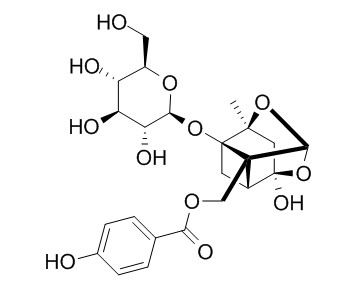Oxypaeoniflorin
Oxypaeoniflorin in rat plasma and was successfully applied to pharmacokinetic study.
Inquire / Order:
manager@chemfaces.com
Technical Inquiries:
service@chemfaces.com
Tel:
+86-27-84237783
Fax:
+86-27-84254680
Address:
1 Building, No. 83, CheCheng Rd., Wuhan Economic and Technological Development Zone, Wuhan, Hubei 430056, PRC
Providing storage is as stated on the product vial and the vial is kept tightly sealed, the product can be stored for up to
24 months(2-8C).
Wherever possible, you should prepare and use solutions on the same day. However, if you need to make up stock solutions in advance, we recommend that you store the solution as aliquots in tightly sealed vials at -20C. Generally, these will be useable for up to two weeks. Before use, and prior to opening the vial we recommend that you allow your product to equilibrate to room temperature for at least 1 hour.
Need more advice on solubility, usage and handling? Please email to: service@chemfaces.com
The packaging of the product may have turned upside down during transportation, resulting in the natural compounds adhering to the neck or cap of the vial. take the vial out of its packaging and gently shake to let the compounds fall to the bottom of the vial. for liquid products, centrifuge at 200-500 RPM to gather the liquid at the bottom of the vial. try to avoid loss or contamination during handling.
Life Sci.2022, 311(Pt A):121157.
FUTURE VIROLOGYVOL.2023, 18(5).
Pest Manag Sci.2019, 75(9):2530-2541
Biol Pharm Bull.2018, 41(11):1645-1651
RSC Adv.2018, 32621-32636
J Plant Biotechnol.2023, 50:070-075.
Biomed Pharmacother.2021, 144:112300.
PLoS One.2017, 12(3):e0173585
Pharm Biol.2017, 55(1):360-366
Molecules.2018, 23(7):E1817
Related and Featured Products
Acta Biochim Pol . 2020 Jun 18;67(2):239-245.
Oxypaeoniflorin improves myocardial ischemia/reperfusion injury by activating the Sirt1/Foxo1 signaling pathway[Pubmed:
32550708]
Abstract
Myocardial ischemia/reperfusion (MI/R) injury is a leading cause of damage to cardiac tissues and is associated with high mortality and disability rates worldwide. Oxypaeoniflorin (OPA) has been found to be the main constituent of Paeonia veitchii Lynch. This study was conducted to explore the effect of OPA on MI/R injury and its potential mechanism. An in vivo MI/R injury model was established by transient coronary ligation in BALB/c mice, and an in vitro hypoxia/reoxygenation (H/R) injury model was established with rat cardiomyocyte H9c2 cells. Echocardiographic assessments demonstrated that OPA significantly reduced disruption of cardiac function and improved the indicators of ejection fraction (EF) and fractional shortening (FS). The enzyme-linked immunosorbent assay (ELISA) results suggested that OPA significantly reduced the release of myocardial infarction-related factors, such as the creatine kinase (CK-MB), cardiac troponin I (cTnI) and cardiac troponin T (cTnT). Additionally, hematoxylin-eosin (HandE) staining demonstrated that OPA markedly inhibited the myocardial apoptosis and necrosis caused by MI/R. Consistently, the results obtained from the cell counting kit-8 (CCK-8) and flow cytometry assays revealed that OPA obviously reversed the H/R-induced decrease in cell activity and increase in apoptosis of H9c2 cells. Furthermore, western blot assays indicated that OPA inhibited apoptosis by activating the Sirt1 (silent information regulator factor 2 related enzyme 1)/Foxo1(forkhead transcription factor FKHR) signaling pathway in myocardial tissues and H9c2 cells. Collectively, these novel findings are the first to provide strong evidence that OPA attenuates MI/R injury by activating the Sirt1 (silent information regulator factor 2 related enzyme 1)/Foxo1(forkhead transcription factor FKHR) signaling-mediated anti-apoptotic pathway.
J Ethnopharmacol. 2010 Jul 20;130(2):407-13.
Pharmacokinetic properties of paeoniflorin, albiflorin and oxypaeoniflorin after oral gavage of extracts of Radix Paeoniae Rubra and Radix Paeoniae Alba in rats.[Pubmed:
20580804]
To establish a HPLC-MS method and investigate the pharmacokinetic properties of paeoniflorin, albiflorin and Oxypaeoniflorin and the pharmacokinetics difference of Radix Paeoniae Rubra and Radix Paeoniae Alba.
METHODS AND RESULTS:
The extracts of Radix Paeoniae Rubra and Radix Paeoniae Alba were separately administrated to rats. The concentrations of paeoniflorin, albiflorin and Oxypaeoniflorin in rat plasma were determined by HPLC-ESI-MS method. The plasma samples were pretreated by protein precipitation with methanol and chromatographic separation was performed on a C(18) column with a mobile phase consisted of 0.1% formic acid and methanol (67:33, v/v). The detection was accomplished by multiple-reaction monitoring (MRM) scanning via electrospray ionization (ESI) source operating in the negative ionization mode. Main pharmacokinetic parameters were estimated and the total AUC of the three components were compared.
The pharmacokinetic parameters of paeoniflorin, albiflorin and Oxypaeoniflorin were significantly different. There was significant difference between the pharmacokinetic characteristics of Radix Paeoniae Rubra and Radix Paeoniae Alba.
CONCLUSIONS:
A specific and sensitive HPLC-ESI-MS method was developed for simultaneous determination of paeoniflorin, albiflorin and Oxypaeoniflorin in rat plasma and was successfully applied to pharmacokinetic study. The results might be helpful for the investigation of different effects of Radix Paeoniae Rubra and Radix Paeoniae Alba.or the investigation of different effects of Radix Paeoniae Rubra and Radix Paeoniae Alba.
Chem Pharm Bull (Tokyo). 2001 Jan;49(1):69-72.
Bioactive constituents of chinese natural medicines. VI. Moutan cortex. (2): structures and radical scavenging effects of suffruticosides A, B, C, D, and E and galloyl-oxypaeoniflorin.[Pubmed:
11201228]
METHODS AND RESULTS:
Five paeonol glycosides, suffruticosides A, B, C, D, and E, and a monoterpene glucoside, galloyl-Oxypaeoniflorin, were isolated from the glycosidic fraction of Chinese Moutan Cortex, the root cortex of Paeonia suffruticosa Andrews, together with paeonolide, apiopaeonoside, galloyl-paeoniflorin, Oxypaeoniflorin, and paeoniflorin. The structures of five suffruticosides and galloyl-Oxypaeoniflorin were elucidated on the basis of chemical and physicochemical evidence.
CONCLUSIONS:
Suffruticosides A, B, C, and D, galloyl-Oxypaeoniflorin, and galloyl-paeoniflorin exhibited more potent radical scavenging effects than alpha-tocopherol.



